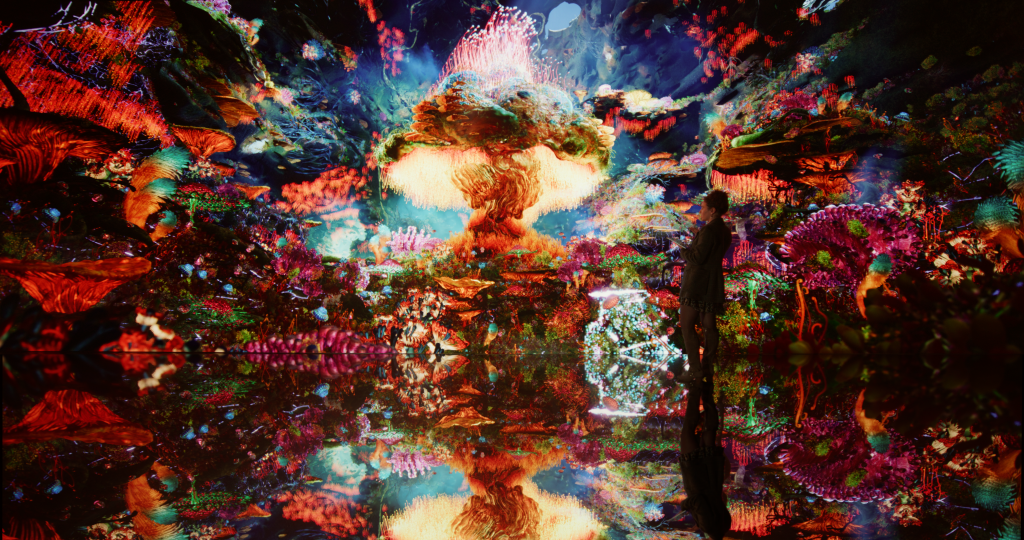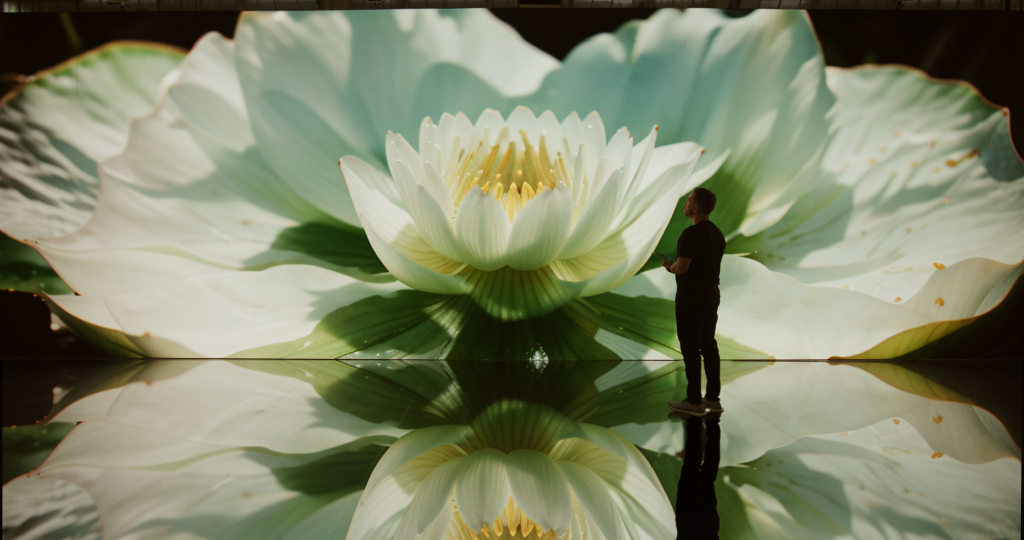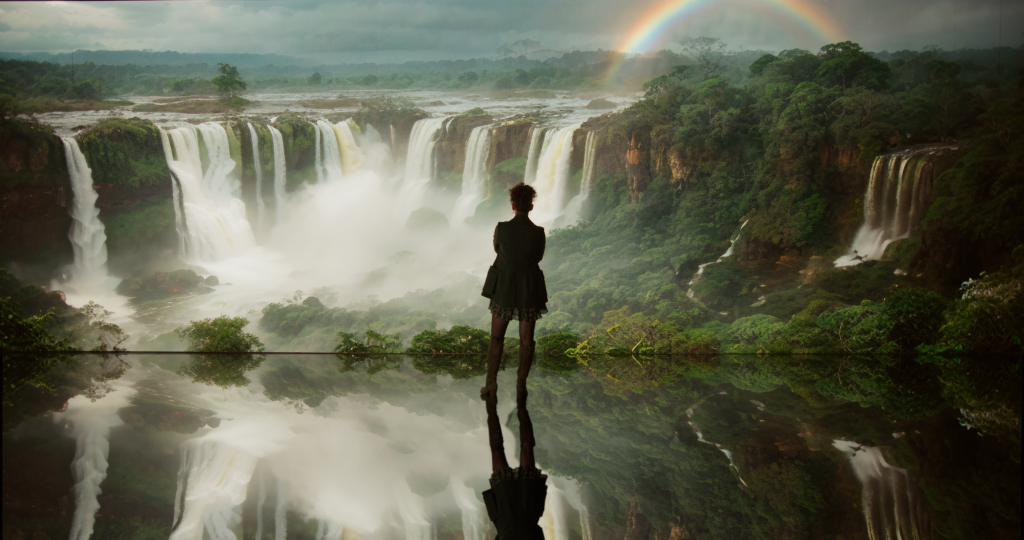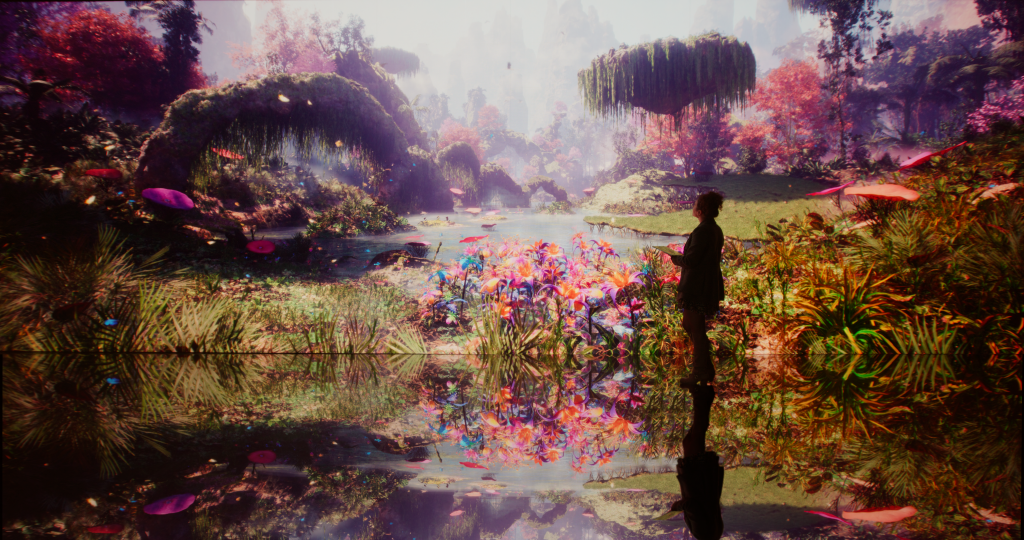Art & Tech
Refik Anadol Launches the World’s First Open-Source A.I. Model Dedicated to Nature
The model uses data from the likes of National Geographic and the Smithsonian Institute to create stunning nature scenes.

The model uses data from the likes of National Geographic and the Smithsonian Institute to create stunning nature scenes.

Adam Schrader

Refik Anadol, known for his installations blending art and technology, has unveiled a new work made using an artificial intelligence model he created at the World Economic Forum in Davos, Switzerland.
The installation being shown in Davos is titled Living Archive: Nature (2024) and is the first installation of early experimental outputs based on the Large Nature Model. It took his studio of workers from 10 countries and speaking at least 15 languages less than a year to complete. It is his second time displaying his work at the meeting of business executives and world leaders to discuss global issues. Last year, his work Artificial Realities: Coral used approximately 100 million coral images as raw data to raise awareness of climate change.
Anadol, 39, spoke via Zoom from the sidelines of the ongoing Davos meeting of world leaders, showing the first look at a new installation created using his A.I. model and the custom-built software he uses to control it from a tablet, revealing a few surprises along the way.
A news release touted the large language model—similar to those used by OpenAI’s ChatGPT and other platforms—as the “world’s first open-source generative A.I. model dedicated to nature,” despite models such as AlphaFold that can determine the shape of a protein in biological organisms and HyenaDNA, which is trained on the human genome. But Anadol clarified via Zoom that his Large Nature Model is the first specific to “literal, physically environmental nature.” He said his team couldn’t find evidence of any other models dedicated to nature and ecology yet in existence.

Refik Anadol. Installation view of Living Archive: Nature (2024). Photo courtesy of Refik Anadol Studio
The Large Nature Model was developed for DATALAND, the future museum for Refik Anadol Studio and a Web3 platform dedicated to data visualization and A.I. arts. Anadol teased that the museum is expected to announce its physical location in March.
The model was trained on data from National Geographic, the Smithsonian Institute, CornellLab, the Natural History Museum in London, and the Conservation Research Foundation Museum, as well as data his team has personally collected at locations around the world, including deep in the Amazon rainforest. His studio used LiDAR, photogrammetry, and captured ambisonic audio and high-resolution visuals of diverse ecosystems for the model.
“We have always blended science and technology,” Anadol said of his work with the institutions, “but now we are literally working with scientists to make art.”

Refik Anadol. Installation view of Living Archive: Nature (2024). Photo courtesy of Refik Anadol Studio
Visuals generated by the model can range from jaw-dropping realism to fantastical landscapes that would make Hollywood jealous. In conversation, Anadol showed what it might look like if you crossed the Amazon rainforest with a more temperate forest. “We learn from nature by experimenting,” he said.
He said his art studio has received an “incredibly positive reaction” from the science community and will share further details about developments in the project and the open-source model, provided free to the public.
“Even the best A.I. model right now does not fully understand nature yet. If you ask them how many bird species we have, they do not have precision,” Anadol said. “We want to take this research to a meaningful and purposeful level and make it truly safe, scientifically safe.”
The CornellLab dataset included a quarter of a million birdsongs from the Amazon, which impressed Anadol. In Living Archive: Nature, “We can hear them and interact with them.” The work shows the data being used in real time and can also retrieve data about weather and environmental conditions in real time from forests around the world, giving his studio full control over the generated environment.
His team also collaborated with Eric Saracchi, a former executive at the perfume maker Firmenich in Geneva, as well as the Alberto Morillas master perfumery, to create 12 different scents to accompany the work. The smells adapt to what is shown on the screen and reach the nose of the viewer through a device worn around the neck. For example, one might experience the smells of the forest before and after a rain begins.

Refik Anadol. Installation view of Living Archive: Nature (2024). Photo courtesy of Refik Anadol Studio
As a “last surprise,” Anadol brought up an “A.I. character” named Fiona who can answer questions related to nature. When asked if humans can create new species with her help, Fiona responded: “Humans are indeed creating new species through selective breeding and genetic engineering, like the development of crops resistant to pests and diseases. But they must tread carefully to maintain the balance of ecosystems.”
Anadol added that he also feels responsibility not to damage the environment further with the development of his A.I. Such technologies are known to take immense computing power, using incredible amounts of energy and requiring the mining of precious metals for parts. So, the artist said his studio also received support from Google and Nvidia.
“We don’t want to damage nature while making a nature model,” Anadol said. “We worked with Google engineers, so we can now exactly see much impact to the environment our model has when it is running and can use only renewable energy when training A.I. model. So, we can do this extremely sustainable, which is possible.”
Anadol also proudly showed off the NFTs in his collection, “Winds of Yawanawa” (2023), a collection of 1,000 unique data paintings that “harness weather data from the tribe’s village in the Amazon rainforest including wind speed, gusts, direction, and temperature.” This data then merges with 13 works by young Yawanawa artists. He promoted the work because he said members of the Amazon tribe would be joining him in Davos, saying they are “now recognized as a world leader.”
“They gave me the name of a bird they call Txanakene in the Amazon, known for mimicking other bird sounds, and they found connection between A.I. and nature,” Anadol said of his time staying with the members of the tribe, who served as advisers for that model.. “It’s a very special moment to hear this moment and becoming one of them.”
The Serpentine North in London will present an exhibition of Anadol’s work titled “Echoes of the Earth: Living Archive” from February 16-April 7. The solo exhibition will include last year’s Coral and the British premiere of this year’s work at the World Economic Forum.
More Trending Stories:
Art Dealers Christina and Emmanuel Di Donna on Their Special Holiday Rituals
Stefanie Heinze Paints Richly Ambiguous Worlds. Collectors Are Obsessed
Inspector Schachter Uncovers Allegations Regarding the Latest Art World Scandal—And It’s a Doozy
Archaeologists Call Foul on the Purported Discovery of a 27,000-Year-Old Pyramid
The Sprawling Legal Dispute Between Yves Bouvier and Dmitry Rybolovlev Is Finally Over